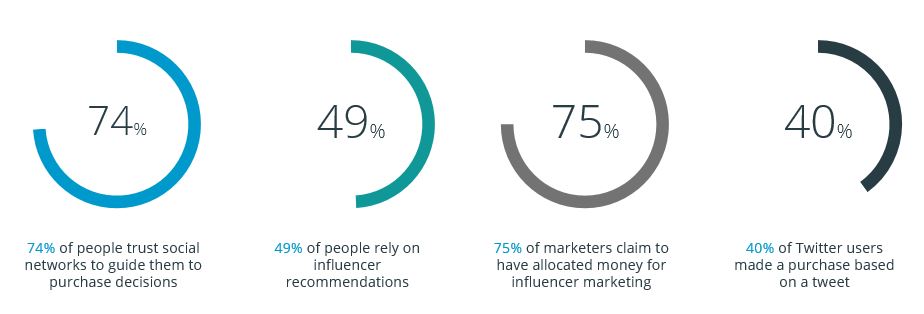In today’s marketplace, it is well-known that a cleverly strategized and executed influencer affiliate marketing program can significantly boost a brand’s popularity and sales. In fact, around 75% of marketers keep a dedicated budget to run influencer affiliate programs. The reason behind such a phenomenon is justified as at least 50% of all social media users have trust in renowned influencers.
As a result, capitalizing on influencer marketing is becoming one of the most common strategies for successful brands. At the same time, the need to bring more innovation and sophistication to influencer affiliate programs is becoming more and more crucial. But how can you successfully set up and operate a profitable influencer affiliate program?
Today, we will answer this question. This article will help equip contemporary marketers with seven essential tips for setting up an influencer marketing program. But before jumping to that, let’s see what an influencer affiliate program actually is.

What Is An Influencer Affiliate Program?
In an influencer affiliate program, marketers reach out to individual influencers on different social media platforms and seek their support in promoting the brand in exchange for a commission or some other form of benefit. These influencers can be contacted personally or through an affiliate network. The commission can be on sales, clicks, traffic, or lead signups. In such programs, special affiliate links or codes are commonly used to identify the sales generated by each hired influencer.
7 Tips For Setting Up An Influencer Affiliate Program
Influencer affiliate programs are beneficial for both the brands and the influencers when it is done right. The influencers get to enjoy the fruits of their invested time and effort on social media, whereas businesses gain more reputation, sales, and valuable insights from the customers to improve the brand image and its offerings further.
However, to enjoy its perks, marketers need to be careful from the beginning when setting up an influencer affiliate program. The following tips include some of the activities that are crucial to ensure your influencer affiliate program’s success.
1. Track Your Target Audience And Competitors Everywhere
Conducting thorough market research is the most important step toward setting up an influencer affiliate program. You need to study which social media platforms your target market is most active on, which influencers they trust the most, what types of content connect with them, and how your competitors use influencer marketing. You will also need to study how such influencers are compensated, what KPIs to track, and what the industry benchmarks for these measures are. Additionally, get a comprehensive overview of how past and present successful influencer affiliate programs have been run. We also recommend studying failed programs to identify potential pitfalls you can avoid.
Doing such extensive research will help you to identify prospective influencers you may want to include in your program, the platforms to target, the strategies to follow, the mistakes to avoid, and, most importantly, the budget to work with. Such market research can be conducted by in-house marketers or external firms specializing in market research. Thanks to the internet, you will find many affiliate research tools and secondary data sources that can help you save time and money.

2. Set Individual Revenue Goals For Every Influencer
Once you know what KPIs to track, you need to set a clear and measurable goal for your program. The primary purpose of most influencer affiliate programs is generating sales. So you can start by selecting a revenue goal that you want the program to bring in per year, quarter, month, or week.
By incorporating individual affiliate links, you can also set particular revenue goals for each influencer. In addition, set a target for the number of clicks, impressions, and leads generated by the influencers, as they will help you to understand how successfully the program is promoting your brand and product.
Setting such goals will give clarity to your vision. It will also help you to evaluate how the program is performing and where you need to revise your strategies. Moreover, with specific goals in mind, you can plan the program structure more effectively and motivate everyone involved to achieve collective success.
3. Motivate The Influencers Through A Well-Planned Compensation Structure
Effectively managing the influencers involved in your program also requires adopting contemporary compensation practices. Although sales commissions are the most common incentives, they are not enough in today’s world. Most influencers now demand an upfront sponsorship payment.
The best way to tackle this compensation structure issue is by combining commissions and one-time sponsorship payments. You can offer a lower upfront payment and an attractive amount for every sale they generate. For example, if an influencer wants $1000 as a one-time payment, you can negotiate by offering $500 upfront and $20 for each sale- encouraging them to earn more than they initially asked for.
You can also offer other incentives to motivate your influencers. Set a measurable and ambitious sales goal and determine a reward upon completion of that goal. These rewards do not have to be only monetary as they can range from a special mention or certificate from the brand to an expensive gift or lavish all-inclusive vacation package. However, keep your expected ROI in mind when determining commission structures and reward policies.

4. Onboard Influencers From Different Channels
Investors and businesses diversify their investments to lower relevant risks and greater returns. The same theory applies here- diversifying your influencer affiliate marketing program by incorporating several influencers on multiple social media platforms can make the marketing strategy more sustainable.
You can reach more potential customers from diversification, and you can rest assured that if one influencer fails, the others can thrive. Additionally, such diversification will fortify your brand’s position on different social media performs- offering you more scope for promotion, potential leads, and future opportunities.
Consider formulating specific strategies for each platform tailored to your influencers and target audience. Keep evaluating the goals against performance periodically to determine where allocating more resources will be profitable. Make sure you have influencers representing all the sub-niches of your target market to promote solidarity and inclusion.
5. Equip Your Influencers With Materials To Make Appealing Content
To influence their followers, influencers need to make authentic content on subjects they truly believe in. They need to use your product or service and be satisfied with it before promoting it. Most influencers test the product in front of the camera to make their own statements more credible to the audience. Therefore, offering free products to the influencers is a common industry practice, and you should do it both before and after onboarding your chosen influencers.
Working with influencers also enables you to get unique content featuring and promoting your product. Thus, work closely with each influencer and focus on building a long-term partnership. Provide key information and revisions as soon as possible to avoid communication gaps, as they can be harmful to your brand’s reputation. Keep sending them marketing materials, such as video samples, catalogs, and cut-outs, so that they can make more appealing content. For example, many brands, such as Bratz and Gucci, send extravagant PR boxes to influencers, and they unbox them on videos- making the content more engaging and the product more enticing.
6. Offer Special Coupon Deals To Boost The Conversion Rate
Influencers can drive people to your website or product, but how do you turn your visitors into buyers? In other words, how do you increase the conversion rate? Here, coupon deals come to the rescue. You can provide your influencers with a unique coupon link or code that they can share with their audience. These coupon deals can be used to obtain a discount, complimentary product, or some other perk with each purchase.
Using coupon codes or referral links helps brands track each influencer’s and platform’s performance as well. When a follower of an influencer uses the code to make a purchase, it is recorded- giving you valuable insight into the effectiveness and efficiency of the influencer.

7. Invest In A Good Tracking Software
It is imperative to keep track of your influencer affiliate program to evaluate its performance and take corrective actions in time. You can do it by periodically collecting sales reports and your influencers’ reports. However, it will take a substantial portion of your valuable time and energy to collect this data manually, whereas instead, you could invest your time into strategizing and improving the program.
Therefore, using tracking software or affiliation management tools is a good way to run the program more effectively. You can integrate them into your online stores as well. They will make it more convenient for you to onboard and manage your influencers, track key performance metrics, scale the program up or down, conduct quick evaluations, etc. Hence, research available tools and invest in the ones that offer you the most value.
Start Planning Your Influencer Affiliate Program
As likes, shares, and influencers are becoming more critical to online marketing strategies, it is essential for forward-thinking marketers to structure influencer affiliate programs carefully. Incorporate innovations in your program, but prioritize a systematic approach to significantly broaden your reach and drive your sales. We hope these seven tips bring you success in growing your brand through an excellent influencer affiliate program.




